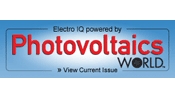The Case for Energy Storage
March 22, 2011
As more intermittent power generation comes on-line (wind, solar power), it makes sense to store the energy for times when the wind isn't blowing or the sun isn't shining.
Energy storage is also driven by a need on the part of utilities for load balancing, since it's expensive for them to constantly adjust the output of traditional power generation systems as the load varies. Energy storage may even allow them to offset or delay the requirement of additional power plants, such as a gas-fired "peaker" plants.
In some markets, there may also be value for companies and people to buy and store power when it is least expensive, and use the stored power during peak demand when prices are highest.
Proponents of solar power, however, like to point out that although PV is intermittent (due to clouds and of course darkness), it's actually highly predictable. Clouds don't cause that much variability if the PV is spread out over a wide enough area, and because they are visible, it's relatively straightforward to predict the impact on power generation.
As noted by John Gartner of Pike Research in Solar, Storage and EVs: A Powerful Trifecta, electric vehicles will also come into play, in part by helping to advance battery technology, but also by becoming an integral part of the smart grid.Futurists envision a time when utilities are so linked into the grid that they can monitor and control electric vehicle battery chargers, and charge them quickly or slowly so as to optimize the load/generation equation. Gartner estimates that 3.1 million EVs will be sold between 2011 and 2015. That's 52MW hours of storage!
Gartner also notes that the current crop of electric vehicles does not include the electronic inverters required to take power from the batteries and deliver it to the grid or building, and there's also concern that the life cycle of the batteries could be reduced.
In short, there are some technical challenges to be solved, but as PV becomes more connected with the grid, and as more EVs hit the road, innovative ways to combine the two are sure to be developed.
 Photovoltaics World, the newest member of PennWell’s
Electronics Group, covers photovoltaics manufacturing
and solar power generation.
Photovoltaics World, the newest member of PennWell’s
Electronics Group, covers photovoltaics manufacturing
and solar power generation.